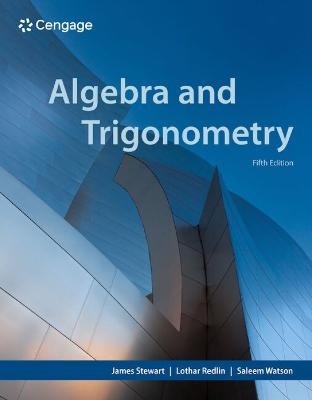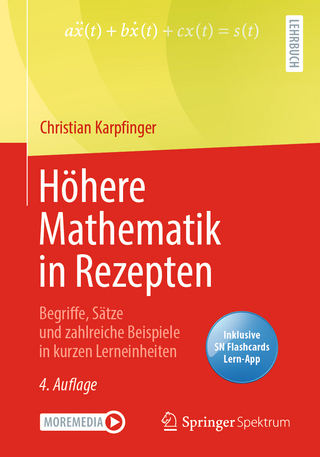
Algebra and Trigonometry
Brooks/Cole (Verlag)
978-0-357-75364-4 (ISBN)
The late James Stewart received his M.S. from Stanford University and his Ph.D. from the University of Toronto. He conducted research at the University of London and was influenced by the famous mathematician, George Polya, at Stanford University. Dr. Stewart most recently served as a professor of mathematics at McMaster University and the University of Toronto. His research focused on harmonic analysis. Dr. Stewart authored the best-selling calculus textbook series, including CALCULUS, CALCULUS: EARLY TRANSCENDENTALS and CALCULUS: CONCEPTS AND CONTEXTS, as well as a series of successful precalculus texts and college algebra and trigonometry texts. The late Lothar Redlin grew up on Vancouver Island and received a bachelor of science degree from the University of Victoria and a Ph.D. from McMaster University. He subsequently did research and taught at the University of Washington and the University of Waterloo as well as California State University, Long Beach. He was most recently a professor of mathematics at The Pennsylvania State University, Abington Campus. His research focused on topology. Dr. Redlin was a valued co-author for Dr. Stewart's best-selling calculus textbook series and his popular precalculus, college algebra and trigonometry texts. Saleem Watson received his bachelor of science degree from Andrews University in Michigan. He completed his graduate studies at Dalhousie University and McMaster University, where he received his Ph.D. Dr. Watson conducted subsequently research at the Mathematics Institute of the University of Warsaw in Poland. He taught mathematics at Pennsylvania State University before serving at California State University, Long Beach, where he is currently professor emeritus. Dr. Watson's research encompasses the field of functional analysis. Dr. Watson is an important co-author for Dr. Stewart's best-selling calculus textbook series as well as his popular precalculus, college algebra and trigonometry texts.
Preface.
To the Student.
Prologue: Principles of Problem Solving.
P. PREREQUISITES.
Chapter Overview. P1. Modeling the Real-World with Algebra. P2. The Real Numbers. P3. Integer Exponents and Scientific Notation. P4. Rational Exponents and Radicals. P5. Algebraic Expressions. P6. Factoring. P7. Rational Expressions. P8. Solving Basic Equations. P9. Modeling with Equations. Chapter P Review. Chapter P Test.
FOCUS ON MODELING: MAKING THE BEST DECISIONS.
1. EQUATIONS AND GRAPHS.
Chapter Overview. 1.1 The Coordinate Plane. 1.2 Graphs of Equations in Two Variables; Circles. 1.3 Lines. 1.4 Solving Quadratic Equations. 1.5 Complex Numbers. 1.6 Solving Other Types of Equations. 1.7 Solving Inequalities. 1.8 Solving Absolute Value Equations and Inequalities. 1.9 Solving Equations and Inequalities Graphically. 1.10 Modeling Variations. Chapter 1 Review. Chapter 1 Test.
FOCUS ON MODELING: Fitting Lines to Data.
2. FUNCTIONS.
Chapter Overview. 2.1 Functions. 2.2 Graphs of Functions. 2.3 Getting Information from the Graph of a Function. 2.4 Average Rate of Change of a Function. 2.5 Linear Functions and Models. 2.6 Transformations of Functions. 2.7 Combining Functions. 2.8 One-to-One Functions and Their Inverses. Chapter 2 Review. Chapter 2 Test.
FOCUS ON MODELING: MODELING WITH FUNCTIONS.
3. POLYNOMIAL AND RATIONAL FUNCTIONS.
Chapter Overview. 3.1. Quadratic Functions and Models. 3.2 Polynomial Functions and Their Graphs. 3.3 Dividing Polynomials. 3.4 Real Zeros of Polynomials. 3.5 Complex Zeros and the Fundamental Theorem of Algebra. 3.6 Rational Functions. 3.7 Polynomial and Rational Inequalities. Chapter 3 Review. Chapter 3 Test.
FOCUS ON MODELING: FITTING POLYNOMIAL CURVES TO DATA.
4. EXPONENTIAL AND LOGARITHMIC FUNCTIONS.
Chapter Overview. 4.1 Exponential Functions. 4.2 The Natural Exponential Function. 4.3 Logarithmic Functions. 4.4 Laws of Logarithms. 4.5 Exponential and Logarithmic Equations. 4.6 Modeling with Exponential Functions. 4.7 Logarithmic Scales. Chapter 4 Review. Chapter 4 Test.
FOCUS ON MODELING: FITTING EXPONENTIAL AND POWER CURVES TO DATA.
5. TRIGONOMETRIC FUNCTIONS: RIGHT TRIANGLE APPROACH.
Chapter Overview. 5.1 Angle Measure. 5.2 Trigonometry of Right Triangles. 5.3 Trigonometric Functions of Angles. 5.4 Inverse Trigonometric Functions and Triangles. 5.5 The Law of Sines. 5.6 The Law of Cosines.
Chapter 5 Review. Chapter 5 Test. FOCUS ON MODELING: SURVEYING.
6. TRIGONOMETRIC FUNCTIONS: UNIT CIRCLE APPROACH.
Chapter Overview. 6.1 The Unit Circle. 6.2 Trigonometric Functions of Real Numbers. 6.3 Trigonometric Graphs. 6.4 More Trigonometric Graphs. 6.5 Inverse Trigonometric Functions and Their Graphs. 6.6 Modeling Harmonic Motion. Chapter 6 Review. Chapter 6 Test.
FOCUS ON MODELING: FITTING SINUSOIDAL CURVES TO DATA.
7. CONIC SECTIONS.
Chapter Overview. 7.1 Trigonometric Identities. 7.2 Addition and Subtraction Formulas. 7.3 Double-Angle, Half-Angle, and Sum-Product Formulas. 7.4 Basic Trigonometric Equations. 7.5 More Trigonometric Equations. Chapter 7 Review. Chapter 7 Test.
FOCUS ON MODELING: TRAVELING AND STANDING WAVES.
8. POLAR COORDINATES, PARAMETRIC EQUATIONS, and VECTORS.
Chapter Overview. 8.1 Polar Coordinates. 8.2 Graphs of Polar Equations. 8.3 Polar Form of Complex Numbers; DeMoivre's Theorem. 8.4 Plane Curves and Parametric Equations. 8.5 Vectors in Two Dimensions. 8.6 The Dot Product. Chapter 8 Review. Chapter 8 Test.
FOCUS ON MODELING: THE PATH OF A PROJECTILE.
9. SYSTEMS OF EQUATIONS AND INEQUALITIES.
Chapter Overview. 9.1 Systems of Linear Equations in Two Variables. 9.2 Systems of Linear Equations in Several Variables. 9.3 Partial Fractions. 9.4 Systems of Nonlinear Equations. 9.5 Systems of Inequalities. Chapter 9 Review. Chapter 9 Test.
FOCUS ON MODELING: LINEAR PROGRAMMING.
10. MATRICES AND DETERMINANTS.
Chapter Overview. 10.1 Matrices and Systems of Linear Equations. 10.2 The Algebra of Matrices. 10.3 Inverses of Matrices and Matrix Equations. 10.4 Determinants and Cramer's Rule. Chapter 10 Review. Chapter 10 Test.
FOCUS ON MODELING: COMPUTER GRAPHICS.
11. CONIC SECTIONS.
Chapter Overview. 11.1 Parabolas. 11.2 Ellipses. 11.3 Hyperbolas. 11.4 Shifted Conics. 11.5 Rotation of Axes. 11.6 Polar Equations of Conics. Chapter 11 Review. Chapter 11 Test.
FOCUS ON MODELING: CONICS IN ARCHITECTURE.
12. SEQUENCES AND SERIES.
Chapter Overview. 12.1 Sequences and Summation Notation. 12.2 Arithmetic Sequences. 12.3 Geometric Sequences. 12.4 Mathematical Induction. 12.5 The Binomial Theorem. Chapter 12 Review. Chapter 12 Test.
FOCUS ON MODELING: MODELING WITH RECURSIVE SEQUENCES.
13. COUNTING AND PROBABILITY.
Chapter Overview. 13.1 Counting. 13.2 Probability. 13.3 Binomial Probability. 13.4 Expected Value. Chapter 13 Review. Chapter 13 Test.
FOCUS ON MODELING: THE MONTE CARLO METHOD.
APPENDIX A: Geometry Review.
APPENDIX B: Calculations and Significant Figures.
APPENDIX C: Graphing with a Graphing Calculator.
APPENDIX D: Using the TI-83/84 Graphing Calculator.
Additional Topics
Vectors in Three-Dimensions (available on website)
Mathematics of Finance (available on website)
| Erscheinungsdatum | 03.01.2023 |
|---|---|
| Verlagsort | CA |
| Sprache | englisch |
| Maße | 230 x 287 mm |
| Gewicht | 2404 g |
| Themenwelt | Mathematik / Informatik ► Mathematik ► Algebra |
| Mathematik / Informatik ► Mathematik ► Geometrie / Topologie | |
| ISBN-10 | 0-357-75364-X / 035775364X |
| ISBN-13 | 978-0-357-75364-4 / 9780357753644 |
| Zustand | Neuware |
| Informationen gemäß Produktsicherheitsverordnung (GPSR) | |
| Haben Sie eine Frage zum Produkt? |
aus dem Bereich


